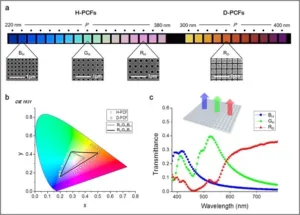A new color filter technology is under development that claims to have the potential to advance the commercialization of the next generation of ultra-high definition TVs. At the same time, the technology also has the potential to reduce TV prices.
First, a few words of background information.
The color filters widely used in current displays are based on the optical absorption of pigments or dyes. Problems suggested for this approach include low chemical stability, since they are based on organic materials, and high unit cost due to the need to manufacture each of the red, green and blue color filters separately.
Another approach to color filters is based on optical interference, so-called plasmon color filters (PCFs).
PCFs can produce all three primary colors from identical materials. The colors are generated from the interference of non-polarized light traveling through a two-dimensional array of subwavelength structures such as holes or dots. The transmitted color is determined only by the geometric parameters (such as the period) of the nanopattern.
The patterns are fabricated from common inorganic materials and use existing manufacturing methods. It follows that PCFs can be produced at low cost. In addition, the microscopic nature of the pattern allows for the formation of very tiny color filters and, thus, the fabrication of displays with ultra-high resolution.
So Where’s the Catch?
PCFs sound great but….up to now, there has been a problem. The optical efficiency of PCFs has not been not good enough to allow them to replace pigment-based color filters.
An effort to address the issue of PCF color was recently announced by The National Research Foundation of Korea (Daejeon, South Korea). The research team was headed by Byeong-kwon Joo of Korea University (Seoul, South Korea. A recent publication by the team on this subject is entitled “Wide-gamut plasmonic color filters using a complementary design method.” It was published in Sci. Rep. 7, 40649; doi: 10.1038/srep40649 (2017). A copy of the article is available on-line and can be found here.
This latest work is built upon several earlier studies on nanostructures employing either hole-arrays or dot-arrays. These earlier studies showed that “H-PCFs were able to express a wide range of colors, but exhibited a weak red color, owing to the color cross-talk. In contrast, the D-PCFs were not able to generate all of the three primary colors, but exhibited a strong red color.”
The new design used in the team’s latest work is called complementary and refers to the fact that it combines a dot pattern with a hole pattern. More specifically, the team investigated a complementary design method for generating high-purity red, green and blue by combining the green/blue filters of hole-arrays with the red filters of dot-arrays.
The results reported by the team were as follows: “the maximum color gamut of the RDGHBH combination was 17% of the NTSC gamut, whereas that of the RHGHBH combination was only 10% of the NTSC gamut. The peak transmittance of RD, GH, and BH was in the 29-40% range and the mean luminance was 16%.” These results are illustrated in the figure below.
These color filter results based on the complementary approach represent a substantial improvement over previously reported PCF results. In addition, the research demonstrated that the complementary PCFs were able to maintain the strong advantage of color tunability, since both the hole and dot PCFs were implemented using an identical layer structure. -Arthur Berman

